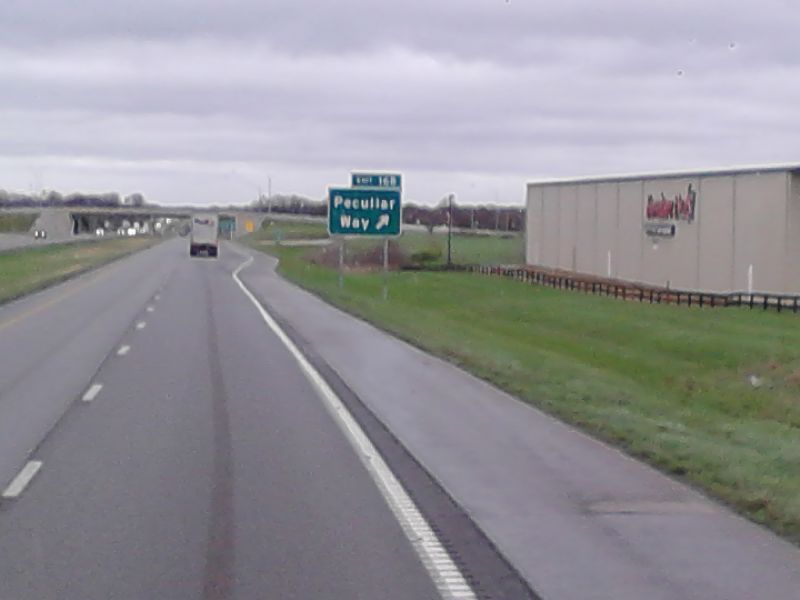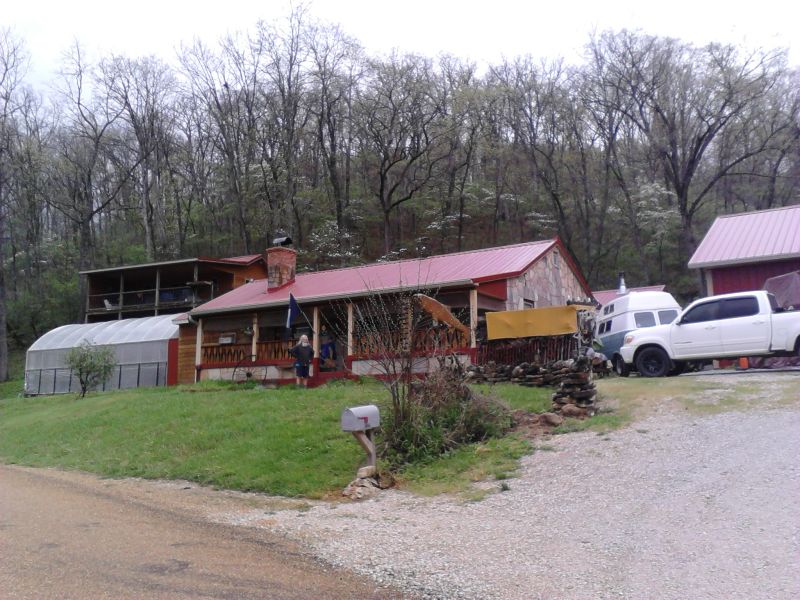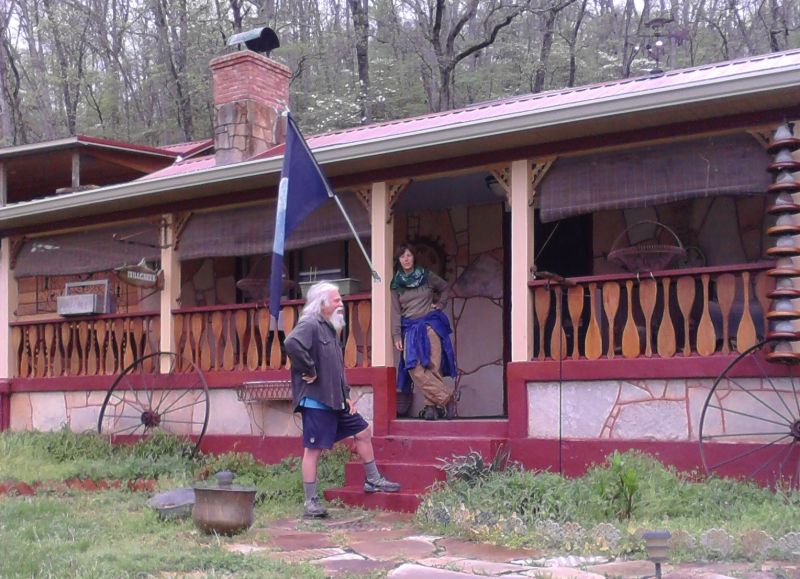Friends We Hadn't Met Yet
The day we were leaving, I spent much of the morning in a mild state of panic, looking at all the good things I was saying goodbye to, and wishing, even though I knew leaving was the right choice, that I could just stay in town where I’m comfy and have all these friends, forever and ever. But our friend Izzy picked us up nonetheless, like we’d asked, and drove us south of town to an I-35 onramp. And then a funny thing happened. Once we got on the pavement, and Izzy had driven away, and we had our thumbs out and our sign flying, all the anxiety blew away like dust off a windowsill in spring, and it felt right and natural to be there.
Our trip has been exactly what we needed and it’s been happening exactly as it needed to. When I was hitching alone a few years ago, rides got me from place to place physically, but this time around, they seem to be getting our spirits where they need to be too. The people we’ve met have been amazing, and they each seem to be putting out a hand to take us one stepping-stone further down the path we’re on. Misty likes to describe hitchhiking as “getting a ride with a friend who we just haven’t met yet.” That seems to be a truer description than I ever remember it being.
Our first new friend was Steve, the trucker from Des Moines who found us on an onramp in his hometown and invited us to walk with him one exit down, to a Cracker Barrel that he’d built in his years as a builder. The next day, besides teaching us about how to track several different animals in the woods, he told us about how he goes to Buckskinner Rendezvous, gatherings of people who like to recreate what life was like before 1840. He makes his own buckskin pants, his own guns, his own black powder, things I never would have thought of making on my own. If they had it before 1840, there has to have been some way to make it, and like as not, it’s something you can figure out in your own garage. My inventive spirit was intrigued. If Steve—who also told us about the time he accidentally destroyed every surface in his kitchen while trying to clean the oven—can figure these things out, it means you don’t have to be Thomas Edison to take do-it-yourself further than you ever imagined, you just need to be reasonably clever and dedicated.

During our ride with Steve, we got confirmation that we were on the right path.
In time, and thanks largely to Steve (who was heading to Little Rock), we got to the Ozarks, specifically to Mark Twain National Forest. For a National Forest, it was peculiarly hard to find. Steve had given us a map of the whole state of Missouri, and it showed a nice big patch of National Forest land—in which anyone is entitled to camp out for free for two weeks at a time—that happened to overlap I-44 about halfway between Springfield and St Louis. We had someone drop us off at an exit that was nicely in the middle of nowhere in that patch of green on our map. And then we wandered around a little befuddled: this all looked like people’s property. We hiked a little down a railroad track that we found there. We kept going, but the forest never looked like it was closing in. Lawns and human things kept coming into view.
We were tired and gave up on finding official Forest land. The railroad here ran on a berm thirty feet above ground level; we scrabbled down the uninhabited side of the berm and pitched our tent in an abandoned creekside pasture that was about fifteen years along toward becoming forest again.
It was a nice place for a couple days, but once we restored our energy enough, we struck out searching for the National Forest once again. We spent a long, hot day walking further down the railroad. Around every bend we expected: “Here’s where the forest will really start.” And then we would see more pasture. Or at best, hillsides with forest, but with no water source and no flat spot for a tent.
Finally we came across some people (for the first time in days), a local family, and they explained to us that these tracks were not the BNSF tracks I thought they were, but belonged to the U.S. Army (making our hike a federal offense), and we weren’t heading east deeper into the green areas of the map but south toward Fort Leonard Wood. The also explained that this National Forest is much more of a Swiss-cheese affair than our map made it look like, and their family was one many that hadn’t sold their land out yet. In the end they got us pointed the right way.
Night fell on us before we could get much farther, and we stayed in a recently burned area among young trees and ashes of the old: National Forest land indeed but forbidding and possibly haunted. But the next morning we knew which way to go and found where we needed to be. It was immediately clear that we’d found the right place, because James was there.
We’d turned to walk down a chip-sealed road where a sign had promised a picnic and recreation area. Another sign said we would also find the Outcast Inn. We set our hearts on getting to the inn: an inn would definitely have water to refill our empty bottles and a surface to put our heavy packs down on for a moment, and it might even have food. Eventually, around a corner, a cheerful family of various-sized red wood-and-stone buildings popped into view.

We went up to the door of one of the buildings to ring, but before we got there, from a different door behind us, a friendly voice called out, “Well, where did you two blow in from?” It was James, proprietor of the Outcast Inn, with long white hair and beard and gleaming eyes, and he told us to put those packs down and come get some water and relax for a little while. Quickly we started getting to know him, through a limitless stream of stories from his life. James is practically an archetypical old hippie. In the ’70s he and his wife raised their five kids in a converted school bus that they drove all around the country, especially New Mexico, where he also later lived with some Buddhists at a commune sort of place. Later he took to building houses and turning over properties, and eventually bought property from Glenn Frey of the Eagles, and in the process made friends with him. He’s been places and he’s known people. And now, after it all, he’s settled down to run a litle fishing inn in Missouri where his family and friends are.
He gave us frozen venison and dried chili to take into the forest with us, and drove us around the vast recreational area to show us good spots to camp. He told us to come back any time if we needed a ride to town. And then he left us where we wanted to be—finally in the forest.
Dogwoods had sprayed the hillsides with white, and the cherry blossoms added their bouquet to the wind. The Mill Creek is clear and fast—the home of the McCloud trout that James’s guests are after—and bright green surrounded us with more coming in fast. After a few uneasy nights close to the public by the creek, we hiked further in and found the best campsite around, next to a steep trickle of clear water on the site of an abandoned hillside farm, a green-shingled chicken coop and some broken old bottles and jars all that remain. We spent days there. First just sitting and watching. Later wandering around, searching unsuccessfully for morels, seeking out the springs that fed our little runnel. We spent a long time meditating. We cooked quinoa and pemmican and beans that we’d brought, and we were at peace.
And we came back to see James. Once we ran out of food we had to take him up on that ride to town to the grocery store. Well, he took us to the grocery store. And then he fulfilled a fantasy we’d been having by taking us to a place around the corner called A Slice of Pie, which has pie and nothing but, in dozens of flavors. We ate apple with ice cream on top. And then he took us on a driving tour of what seemed like the entire county, showing us places he’d once lived, properties he’d fixed up, old homes of deceased relatives, places where history of some sort or another had happened, and the old sprawling Grotto where a lot of his family lived. And then he took us to a series of restaurants of increasing classiness and cavernousness, each one a place where he knew the chef or knew they were doing excellent things, and at each one he insisted on buying us delicious wine or a flight of beer and food. That morning we’d imagined going and getting groceries and walking right back into the forest, but this was an extremely acceptable deviation from our plan, and we ended up getting back so late that we had to sleep on the outdoor beds next to his hot tub.

James and Misty shoot the breeze on the porch.
Being originally from the city, when I’ve thought about “moving out to the country”, a theme that’s popped up in my thoughts is isolation. Will it just be me and Misty and whoever’s in the community? Will I know only the same ten people the rest of my life? The tour James took us on demonstrated that it’s possible to have a whole riot of friends around you even if the nearest city is Rolla, population 19,559 and a twenty-minute drive away.
After two weeks in the Ozarks we’d gotten our forest time and slowed ourselves down, and we’d gotten the bonus of learning from James about the more wonderful points of country life. So we thought it was time to move on. James dropped us off one evening at the I-44 onramp and we pointed ourselves toward The Draw.
We had a sign saying Illinois, but I didn’t even have time to finish making our second sign—just showered—before a truck cab pulled onto the shoulder in front of us.
Inside we met Luria. Lu transports trucks, and this truck was bound all the way for Chicago—instantly lifting off of us the worry of how to get through St Louis; Springfield, Illinois; and Bloomington–Normal. “We’ve had amazing luck so far, and now even more good luck finding you!” Misty said as we were exchanging politenesses and getting to know each other.
“I don’t believe in luck,” said Lu.
“What do you believe in?” Misty said, as I braced myself for a long ride of Jesus talk.
“The Great Spirit,” Lu said. “Miigwech, Gichi-Manidoo.” I’m sure my eyes bugged out. You don’t expect to hear Ojibwe spoken in a stranger’s truck cab in Missouri. Lu, we learned, is by blood half-Ojibwe, and by spirit clearly one hundred percent. She lives her life helping out anyone who needs to be helped out. She doesn’t have much herself, but whatever she has she gives, and Gichi-Manidoo always eventually finds a way to give it back. She’s picked up hitchhikers of every description, a lot of them lost in a fog of drugs, and she’s seen many other people get lost in the same fog, and she always tells them just what they need to hear in order to help themselves out. We heard her talking on the phone with a tough-guy type from back on the reservation in Wisconsin, who’s fallen into alcoholism, and she matched his tough-guy comments jab for jab, and showed him what he looked like, and planted the seeds of how he can stop destroying himself. It sounded like just a raunchy conversation, but when she explained it later it sounded like great spiritual work.
Over the course of the ride we dug deep into how to live right and live a real life. Of many things that were good to hear, a couple I remember are:
“If you want to make Gichi-Manidoo laugh, just tell him your plans.”
“[The elder] asked me, ‘Will you take this boy’s pain on so we can save his foot?’ I said, ‘I will try.’ He got madder than I’ve ever seen him! He yelled and yelled at me. Finally I understood he was saying, ‘I didn’t ask, “Will you try?” I asked, “Will you?” ’ ”
She also taught us traditions we didn’t know. She taught us to honor the spirits of animals we see dead on the road. She taught us something more of the meaning behind putting down tobacco. She taught us that it’s not important exactly how you carry out a tradition, because the tradition is there to help your spirit remember something, and that’s what’s really important. So if you go to another tribe’s ceremony just do what they do, instead of insisting on what you were taught.
We rode with Lu for 2½ days, not just to Chicago but, once she’d delivered that truck and then another one, back home with her to northern Wisconsin, and then all the way to the Draw. On the reservation we stopped to gather cedar boughs for our fast later this month. On Highway 13 we put tobacco down for a dead seagull and cut their wings off to take with us for whenever we may find a use for them (bird wings are used in some ceremonies).
Lu had dinner at The Draw, and then left us to stay there. And we began our month of finding out whether it’s for us.
So far the answer strongly seems to be yes. My reservations about it have dissolved as I’ve learned more. The vision they have there for the place’s future is what an older, smarter me might have been able to dream up, except it’s not just a dream. There’s a lot of hard work, but it’s necessary work, and it has concrete rewards. Above all, life makes sense there. But I’m not going to go too deeply into this; there will be plenty of time for philosophizing about The Draw if, as we suspect we will, we end up living there. For now let it be enough to say that it feels very much like it could be home.
And now here we are in Minneapolis. The city feels very strange. We’ve seen what life looks like when it makes sense, and now we know that’s not this. All the houses! They look so temporary and slipshod, children’s blanket forts set up for a moment on top of living land to which they have no relation. The concrete and the cars are constant intrusions, and there’s never not noise. But our friends are here, and we’ve had an excellent visit back with them. The MayDay Parade was worth the trip for its vision of a world where balance has been restored and everything is based on love. But besides that there’s been reunions with the Seward Cafe, a guitarry bonfire on a river beach last night, and many good conversations. We’re looking forward to getting back out on the land and on the road, but it’s been nice to be back for a little while.
File under: Year of Transformation, interesting people, Anishinaabe, The Draw, friends, hitchhiking · Places: Midwest, The South
Note: comments are temporarily disabled because Google’s spam-blocking software cannot withstand spammers’ resolve.
3 Comments
CICADA
HistoryWHOO HOOOO! AND I GET TO SEE YOU TWO LOVELIES SOON AS WELL!
Chuck
HistoryAnd not once but at least twice!
Steve
HistoryI’m so honored to have put my camp stake down onto your journey as to finding out whom you really are.